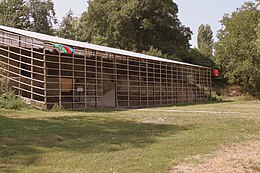| Revision as of 02:57, 29 September 2024 editAllenkong11 (talk | contribs)Extended confirmed users14,817 editsmNo edit summary← Previous edit | Revision as of 00:26, 7 January 2025 edit undoBbb23 (talk | contribs)Autopatrolled, Administrators271,091 edits no reason not to have TOCNext edit → | ||
| Line 1: | Line 1: | ||
| __NOTOC__ | |||
| {{Infobox cemetery | {{Infobox cemetery | ||
| | name = Quba mass grave | | name = Quba mass grave | ||
Revision as of 00:26, 7 January 2025
| Quba mass grave | |
|---|---|
| Quba kütləvi məzarlığı | |
 | |
| Details | |
| Location | Quba |
| Country | Azerbaijan |
| Type | Mass grave |

The Quba mass grave is a mass grave site claimed to be from 1918 located in the town of Quba in northeastern Azerbaijan, however there is no evidence or primary source attesting to a massacre occurring there at that time. It was discovered during the building of a stadium in April 2007.
Investigation
| The neutrality of this section is disputed. Relevant discussion may be found on the talk page. Please do not remove this message until conditions to do so are met. (November 2020) (Learn how and when to remove this message) |
Once the burial site was uncovered, the Institute of Archeology and Ethnography of the Azerbaijan National Academy of Sciences dispatched a forensic expedition to the location. The expedition released its first forensics report on April 13, 2007, stating that the preponderance of commingled skeletal remains suggests that the people were first executed and then thrown into wells, 2.5 to 5 meters deep. Gahraman Agayev, the leader of the forensic expedition, followed up on this by reporting the discovery of two main wells and two canals with human bones. The research has discovered the remains of more than 400 people belonging to different age groups in the grave. Of these, 50 belong to children, more than 100 to women and others mainly to elderly men. The Azerbaijani government stated that the burial was from a massacre committed against the local population by Armenian gangs in 1918.
Reactions
In response to the mass grave discovery, Levon Yepiskoposyan, supervisor of Human Genetics at the Institute of Molecular Biology in the Armenian National Academy of Sciences and president of the Armenian Anthropological Society, and Hayk Kotanjian, President of the Association of Political Science at the Ministry Doctor of Political Sciences, sent letters urging the President of the National Academy of Sciences of Azerbaijan, Mahmud Kerimov, to form a joint committee to examine the remains found. As of 2013, those letters have not received a response from Azerbaijani officials.
Hayk Demoyan, the director of the Armenian Genocide Museum-Institute, has stated that no foreign experts have examined the human remains.
References
- "Б. Сафаров. Установить всех жертв поименно не удастся". Эхо. Archived from the original on August 15, 2011. Retrieved June 9, 2011.
- "Ilham Aliyev attended the opening of the Guba genocide memorial", Official web-site of President of Azerbaijan Republic, retrieved 1 January 2023
- Армянские политологи против политики ксенофобии Ильхама Алиева: кто же захоронен в Губе? (in Russian). Regnum. 2 November 2012. Retrieved 1 June 2013.
- Demoyan, Hayk (14 September 2010). Когда Губа не дура, или особенности национального геноцидостроения а Азербайджане. Golos Armenii (in Russian). Hayk Demoyan. Archived from the original on 7 May 2016. Retrieved 1 June 2013.
External links
| Anti-Azerbaijanism | |
|---|---|
| Events |
|
| See also | |
41°21′40″N 48°29′30″E / 41.36111°N 48.49167°E / 41.36111; 48.49167
Category: